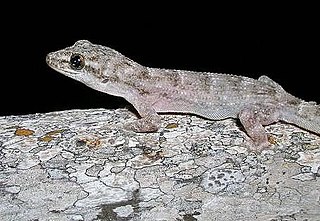
Spiny lizards is a common name for the genus Sceloporus in the family Phrynosomatidae. The genus is endemic to North America, with various species ranging from New York, to Washington, and one occurring as far south as northern Panama. The greatest diversity is found in Mexico. This genus includes some of the most commonly seen lizards in the United States. Other common names for lizards in this genus include fence lizards, scaly lizards, bunchgrass lizards, and swifts.

Abronia is a genus of lizards in the family Anguidae that is native to Mexico and Central America. The majority of the species are restricted to southern Mexico and Guatemala, but members of the genus occur as far south as Panama. They inhabit forests and woodlands, mostly in highlands, and some species are often associated with bromeliads. They are typically arboreal, but there are also terrestrial Abronia species. Many species are considered threatened due to habitat loss, killing by locals who mistakenly believe they are venomous, or collection for the captive reptile trade. They feed on small animal prey, such as insects, and the females give birth to live young.
The western leaf-toed gecko is a species of gecko. It is endemic to Peru. It was described by Johann Jakob von Tschudi in 1845.

The narrow leaf-toed gecko is a medium-sized gecko with a maximum snout-vent length of 57 mm.

Phyllodactylus xanti is a species of lizard in the family Phyllodactylidae. It is endemic to northwestern Mexico. It is also known as the leaf-toed gecko or Raza Island leaf-toed gecko when referring to the subspecies from the Isla Rasa; at present, there are altogether four recognized subspecies, while several more have been recognized previously.

Eleutherodactylus is a genus of frogs in the family Eleutherodactylidae. Many of the 200 species of the genus are commonly known as "rain frogs" or "robber frogs", due to their sharp, high-pitched, insect-like calls.

James Ray Dixon was professor emeritus and curator emeritus of amphibians and reptiles at the Texas Cooperative Wildlife Collection at Texas A&M University. He lived in El Campo, Texas, throughout most of his childhood. He published prolifically on the subject of herpetology in his distinguished career, authoring and co-authoring several books, book chapters, and numerous peer reviewed notes and articles, describing two new genera, and many new species, earning him a reputation as one of the most prominent herpetologists of his generation. His main research focus was morphology based systematics of amphibians and reptiles worldwide with emphasis on Texas, US, Mexico, Central America, and South America, although bibliographies, conservation, ecology, life history and zoogeography have all been the subjects of his extensive publications.

The coastal leaf-toed gecko or Tumbesian leaf-toed gecko is a species of lizard in the family Phyllodactylidae. The species is endemic to South America.

Hyloscirtus is a genus of Neotropical frogs in the family Hylidae. This genus was resurrected in 2005 following a major revision of the Hylidae, with the distinguishing features being 56 transformations in nuclear and mitochondrial proteins and ribosomal genes. Of these species, 28 species, previously placed in the genus Hyla, were moved to this genus. The fingers and toes of these frogs have wide dermal fringes.
The Lima leaf-toed gecko has been registered in six archeological sites in Lima, Peru, where it is endemic. It is considered a species in critical danger.

Epictia is a genus of snakes in the family Leptotyphlopidae. The genus is native to South America, Central America, and Mexico.

Atractus is a genus of colubrid ground snakes in the subfamily Dipsadinae. The genus includes more than 140 distinct species.
Del Campo's leaf-toed gecko, also known commonly as la salamanquesa de del Campo in Spanish, is a species of lizard in the family Phyllodactylidae. The species is endemic to Mexico.
Phyllodactylus delsolari is a species of gecko, a lizard in the family Phyllodactylidae. The species is endemic to Peru.
Duellman's pigmy leaf-toed gecko, also known commonly as la salamanquesa pigmea de Duellman in Mexican Spanish, is a species of lizard in the family Phyllodactylidae. The species is endemic to Mexico.
The Rio Huancabamba leaf-toed gecko is a species of lizard in the family Phyllodactylidae. The species is endemic to Peru.

Phyllodactylus reissii, also known commonly as Peters' leaf-toed gecko or the coastal leaf-toed gecko, is a species of lizard in the family Phyllodactylidae. The species is endemic to northwestern South America.
Phyllodactylus thompsoni is a species of gecko, a lizard in the family Phyllodactylidae. The species is endemic to Peru.











